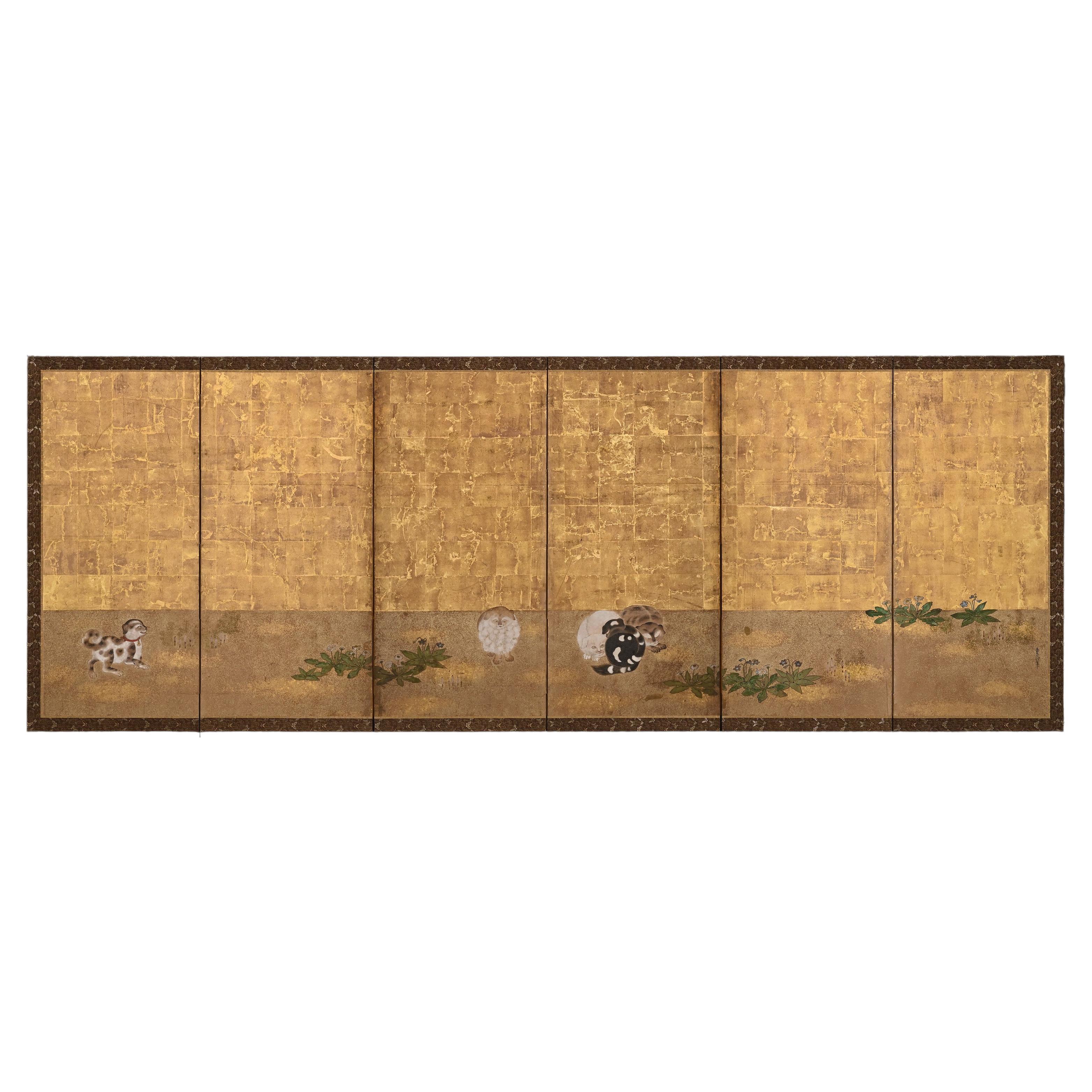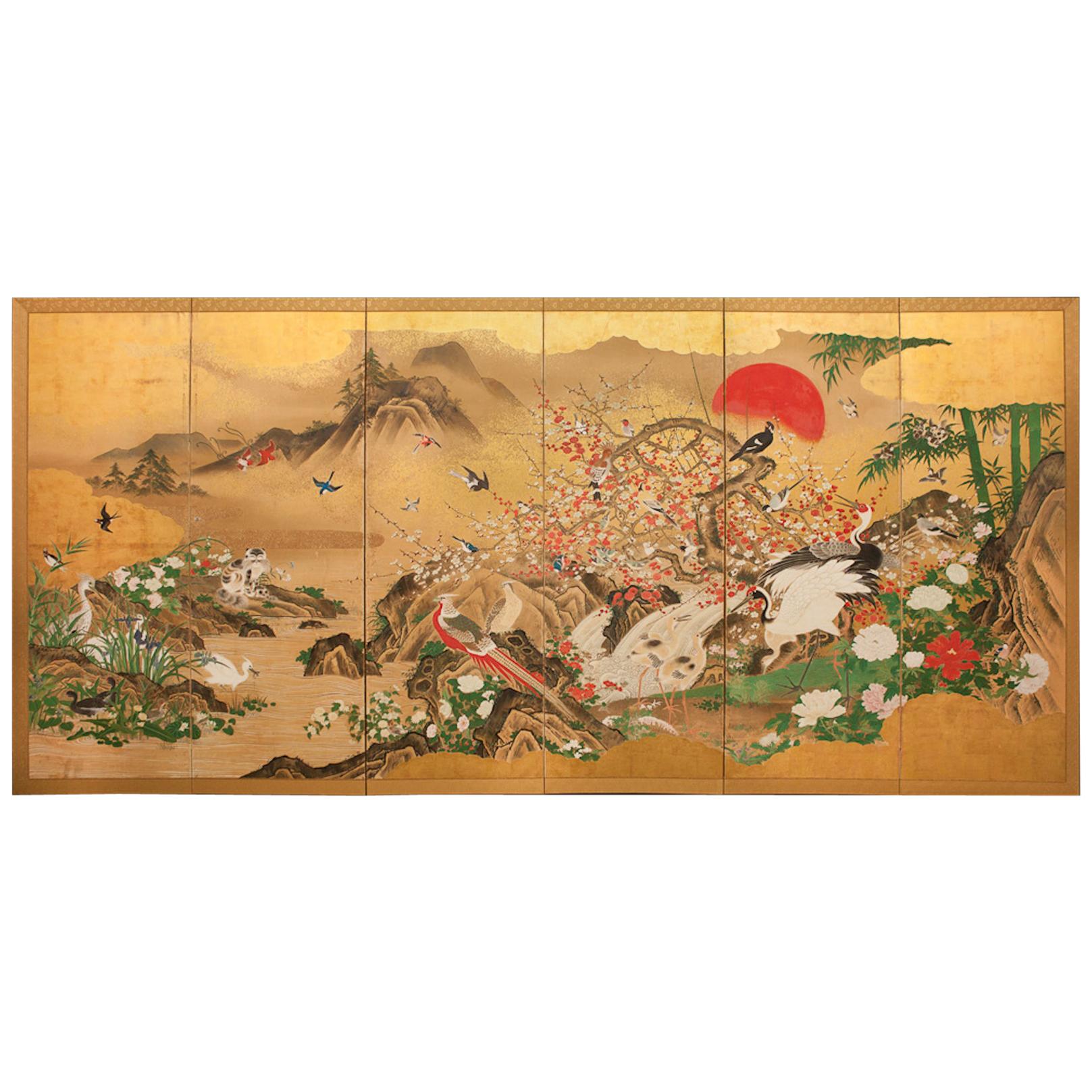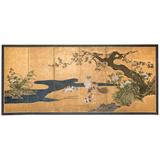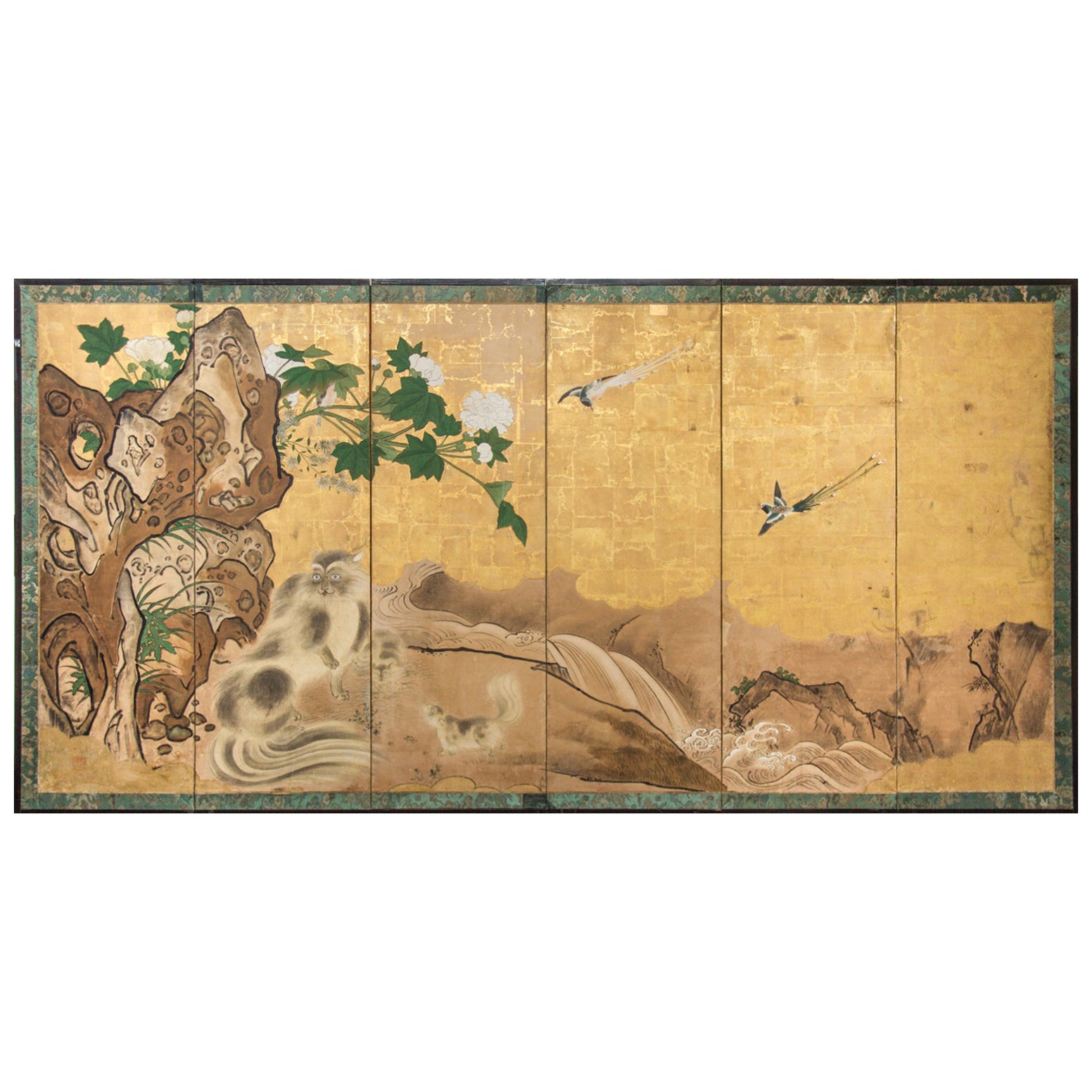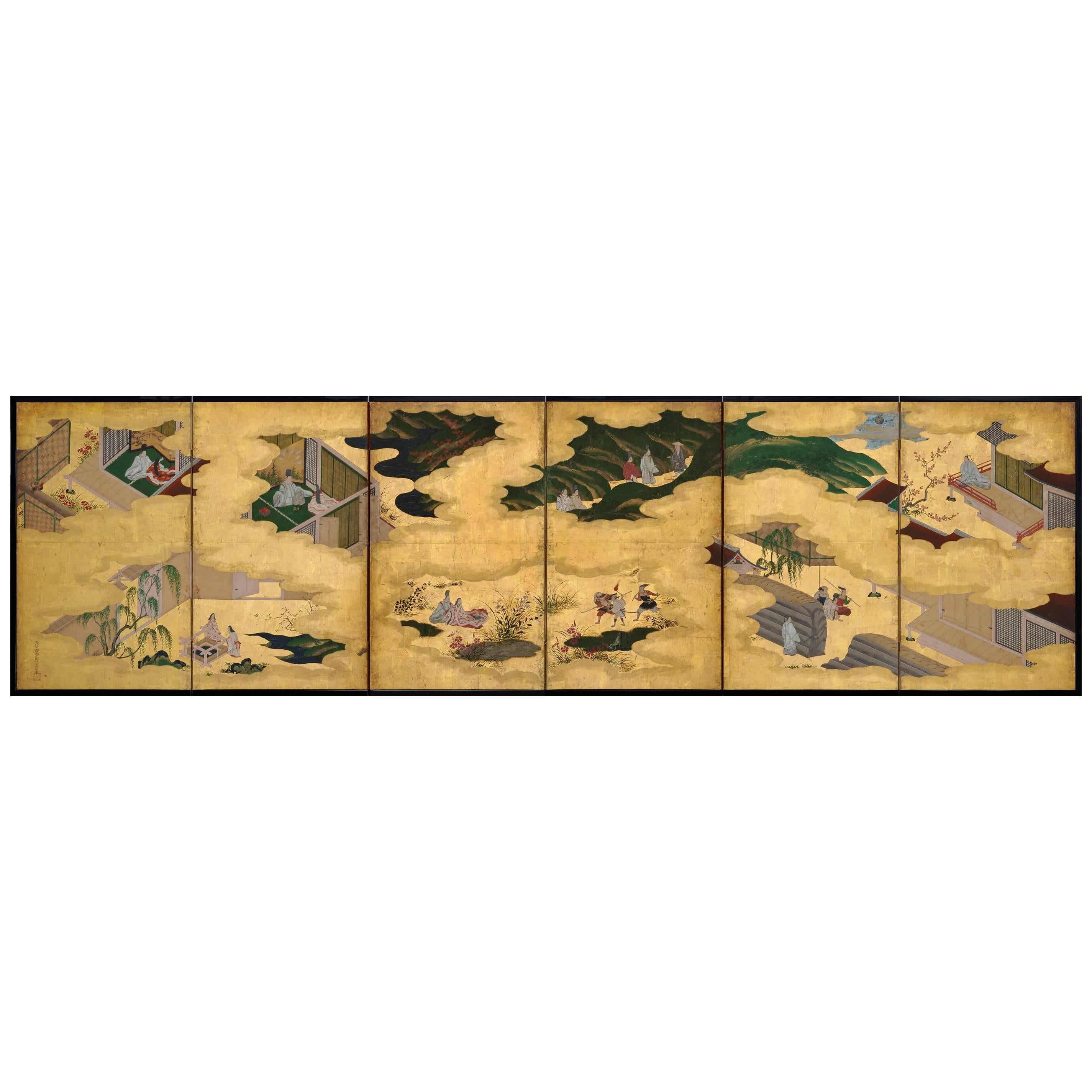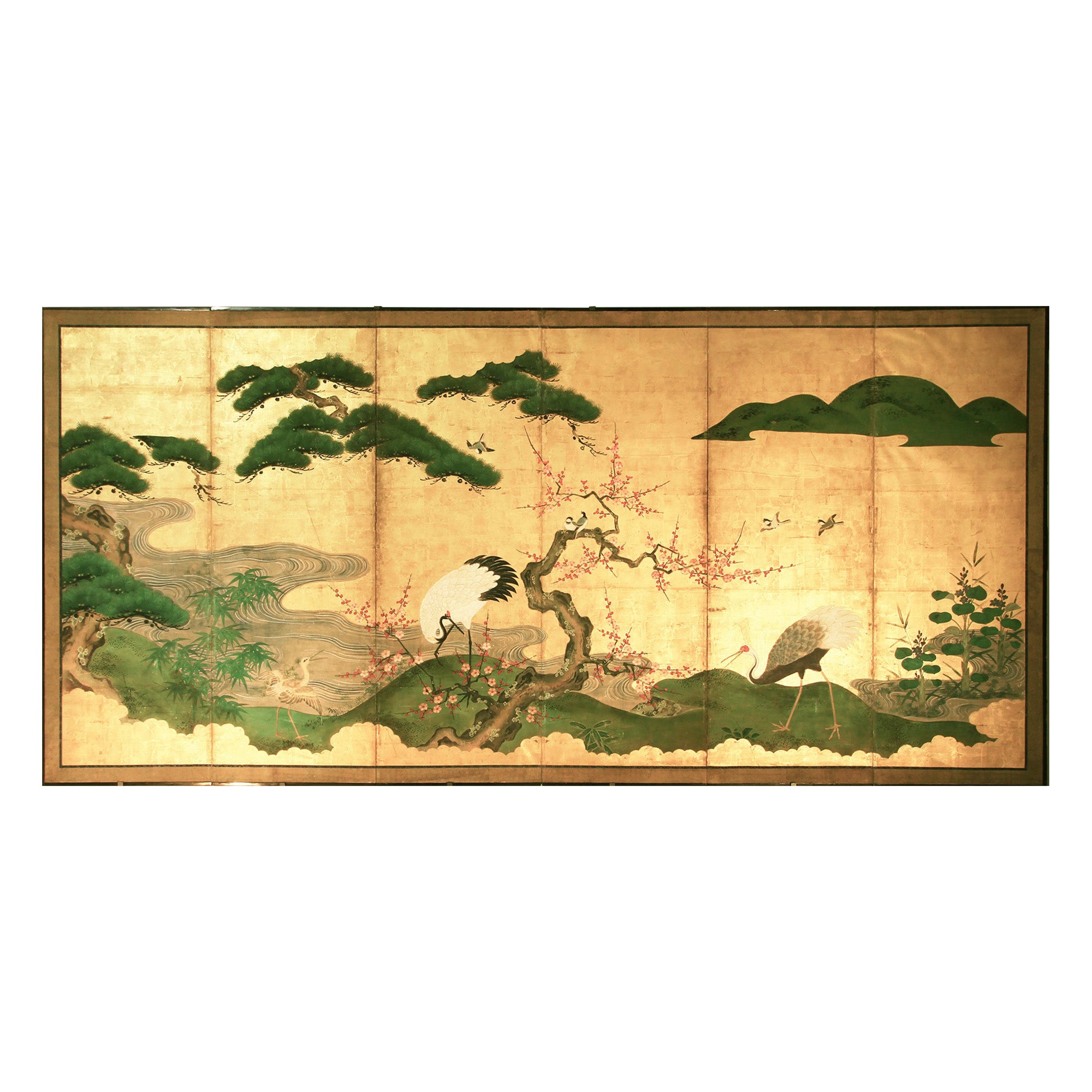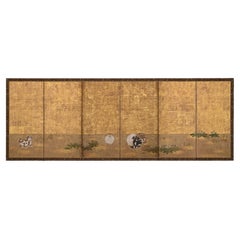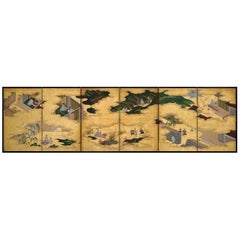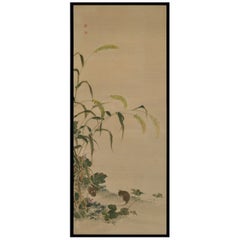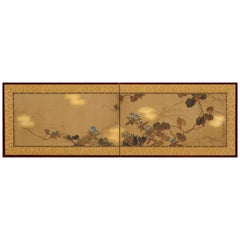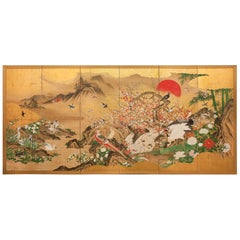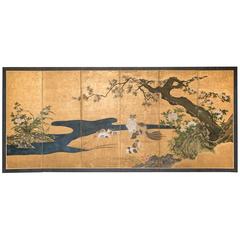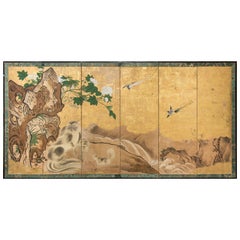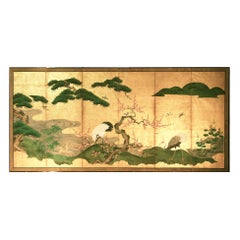Items Similar to Circa 1920 Japanese Screen. Cat & Mouse Harvest Scene on Gold Silk.
Want more images or videos?
Request additional images or videos from the seller
1 of 9
Circa 1920 Japanese Screen. Cat & Mouse Harvest Scene on Gold Silk.
$35,000
£26,571.40
€30,392.02
CA$48,900.08
A$54,387.56
CHF 28,399.49
MX$661,838.73
NOK 362,704.86
SEK 340,153.17
DKK 226,827.27
Shipping
Retrieving quote...The 1stDibs Promise:
Authenticity Guarantee,
Money-Back Guarantee,
24-Hour Cancellation
About the Item
The narrative playfulness of the scene depicted on this Japanese screen sets alight what is at its core a celebration of a bountiful harvest. The screen offers a visual representation of the abundance of nature and the wish for ongoing prosperity. It is closely tied to the seasons and in this case spring, summer, autumn and winter are all represented. The plethora of freshly harvested vegetables includes new season ginger, Chinese wax gourd, butterbur, welsh onion, Japanese radish, sweet potato, lotus root, soy beans and aubergine. The artist has employed meticulous attention to detail in the depiction of the vegetables as well as the use of vibrant colors and an intricate composition to bring the scene to life, but ultimately the cat and mouse steal the show. It is a stunning example of capturing the lifelike qualities of a cat, portrayed with an intense focus on its movement and expression. Hidden amongst the aubergines is the protagonist of the scene; a small grey mouse. In pursuit, the cat has upended the basket of vegetables. We can still sense the aubergines rolling. The mouse’s body shape and tail mimic the aubergines and the cat has caught the wrong tail.
Otaki Uzan (1871-1939) studied painting with Entan Ichihara and Haizan Ishikawa. He later moved to Tokyo and studied under Amaya Kawamura. and was predominantly known for his landscape paintings. He was a decorated artist and served as a member of the Japan Art Association and as a councllior of the Japan Nanshu (Southern school of Chinese painting) Association. He was a regular national exhibitor and awarded artist. He exhibited at the Japan Painting Association in 1909, 1910, 1912 (honorable mention), 1913,1914 (commendation), 1915 (3rd prize and silver medal), 1916 (bronze medal), 1917 (bronze medal), 1918 (bronze medal), 1919 (bronze medal), 1923, 1924, 1926, 1928 and 1933. He was also selected to exhibit with the Bunten in 1915 and 1916.
- Dimensions:Height: 54 in (137.16 cm)Width: 107.5 in (273.05 cm)Depth: 0.75 in (1.91 cm)
- Style:Taisho (Of the Period)
- Materials and Techniques:
- Place of Origin:
- Period:
- Date of Manufacture:Circa 1920
- Condition:Refinished. Wear consistent with age and use. The screen has recently been completely remounted utilizing traditional craftsmen and techniques.
- Seller Location:Kyoto, JP
- Reference Number:1stDibs: LU2472336431902
About the Seller
5.0
Recognized Seller
These prestigious sellers are industry leaders and represent the highest echelon for item quality and design.
Established in 2001
1stDibs seller since 2016
70 sales on 1stDibs
Typical response time: 6 hours
- ShippingRetrieving quote...Shipping from: Kyoto, Japan
- Return Policy
Authenticity Guarantee
In the unlikely event there’s an issue with an item’s authenticity, contact us within 1 year for a full refund. DetailsMoney-Back Guarantee
If your item is not as described, is damaged in transit, or does not arrive, contact us within 7 days for a full refund. Details24-Hour Cancellation
You have a 24-hour grace period in which to reconsider your purchase, with no questions asked.Vetted Professional Sellers
Our world-class sellers must adhere to strict standards for service and quality, maintaining the integrity of our listings.Price-Match Guarantee
If you find that a seller listed the same item for a lower price elsewhere, we’ll match it.Trusted Global Delivery
Our best-in-class carrier network provides specialized shipping options worldwide, including custom delivery.More From This Seller
View AllLate 17th Century Japanese Screen. Puppy and Kittens on Gold Leaf.
Located in Kyoto, JP
Anonymous
Late 17th century
Puppy & Kittens
A six-panel Japanese screen. Ink, color, gofun, gold-leaf and gold-fleck on paper.
A medium sized late 17th century Japanese screen fe...
Category
Antique Late 17th Century Japanese Edo Paintings and Screens
Materials
Gold Leaf
Japanese Screen Painting, Circa 1700 'Tales of Ise' by Tosa Mitsusuke
By Tosa Mitsusuke 1
Located in Kyoto, JP
A six-fold Japanese screen by Tosa Mitsusuke (1675-1710), Japan 17th-18th century, Edo period.
The signature reads Shoroku-i ge Tosa sa Konoe Shogen Mit...
Category
Antique Late 17th Century Japanese Edo Paintings and Screens
Materials
Gold Leaf
Mid 19th Century Framed Japanese Painting. Mice & Millet
Located in Kyoto, JP
Obata Tosho (1812-1886)
Mice & Millet
Late Edo period, mid 19th Century
Framed Japanese Painting. Ink and color on paper.
Individually framed 19th century bird and flower paintin...
Category
Antique Mid-19th Century Japanese Edo Paintings and Screens
Materials
Paper
Japanese Screen Painting, Early 19th Century, Autumn Flowers by Sakai Hoitsu
Located in Kyoto, JP
A two-fold Japanese screen by the Rimpa school artist Sakai Hoitsu (1761-1828), Japan, 19th century, Edo period.
This small Japanese folding screen pai...
Category
Antique Early 19th Century Japanese Edo Paintings and Screens
Materials
Wood, Silk
Japanese Screen, Early 20th Century Wagtail & Chrysanthemum by Ishizaki Koyo
Located in Kyoto, JP
Ishizaki Koyo (1884-1947)
Wagtail & Chrysanthemum
Early 20th century
Folding screen in two-panels. Ink, pigments and gofun on gold leaf.
Sign: Koyo
Seal: Koyo
This ...
Category
Early 20th Century Japanese Taisho Paintings and Screens
Materials
Gold Leaf
19th Century Japanese Screen for Tea-Ceremony, Ink Bamboo and Plum on Gold Leaf
Located in Kyoto, JP
Three Friends of Winter
Nakajima Raisho (1796-1871)
Late Edo period, circa 1850
Ink and gold leaf on paper.
This is a double-sided Japanese Furosaki or tea-ceremony screen from the mid 19th century; bamboo and plum on the front, young pines the back. It by Nakajima Raisho, a master painter of the Maruyama school in the late Edo and early Meiji periods. In this work Raisho combines exquisite ink brushwork with large open spaces of brilliant gold-leaf to inspire the viewers imagination. Rather than naturalism, he is searching for the phycological impression of the motifs, resulting in abstraction and stylization. His simplification of the motifs the result of looking to capture the inner nature of the objects. This art motif is known as Sho Chiku Bai, or the Three Friends of Winter. Evergreen pine connotes steadfastness, bamboo suggests both strength and flexibility, while plum blossoms unfurling on snow-laden branches imply hardiness. Combined, this trio is emblematic of Japanese new year. Chinese literati were the first to group the three plants together due to their noble characteristics. Like these resilient plants flowering so beautifully in winter, it was expected of the scholar-gentleman to cultivate a strong character with which he would be able to show the same degree of perseverance and steadfastness even during times of adverse conditions.
The screen would have been placed near the hearth of a room used for the Japanese tea ceremony, shielding the fire from draughts and also forming a stimulating and decorative backdrop behind the tea utensils. It would have been used in the Hatsugama, or first tea-ceremony of the new year.
Nakajima Raisho (1796-1871) originally studied under Watanabe Nangaku before entering the school of Maruyama Ozui. He was the highest ranking Maruyama school painter at the end of the Edo period and was known as one of the ‘Four Heian Families’ along with Kishi...
Category
Antique Mid-19th Century Japanese Edo Paintings and Screens
Materials
Gold Leaf
You May Also Like
Japanese Screen: Animals and Flowers in a Landscape with Rising Sun
Located in Hudson, NY
Edo period (c. 1800) screen, beautifully painted with excellent details. Kano School painting at its best. An exuberant Audobon landscape being observed by a cat and her kitten. A...
Category
Antique Early 19th Century Japanese Edo Paintings and Screens
Materials
Gold Leaf
Japanese Six-Panel Screen "Mother and Her Kittens"
Located in Hudson, NY
Japanese six-panel screen: Mother and her kittens under flowering cherry tree.
Kano School painting, mineral pigments on gold, with beautiful early bronze mounts.
Category
Antique Late 18th Century Japanese Paintings and Screens
Materials
Gold Leaf
Japanese Six Panel Screen Mother Cat and Kittens Near Rushing Stream
Located in Hudson, NY
Kano School painting, in mineral pigments and gold leaf on mulberry paper with a silk brocade border. Artist seal reads: Hokkyo Unsen.
Category
Antique Early 19th Century Japanese Paintings and Screens
Materials
Gold Leaf
Byobu - Japanese Screen "Kano School" Gold Leaf
By Japanese Studio
Located in Brescia, IT
Japanese Kano School Six Panel Screen: Landscape with Beautiful and Elegant Cranes near the River, with Pines and Sakura.
Hand painted with mineral pigments and inks on vegetable pap...
Category
Antique Late 18th Century Japanese Edo Paintings and Screens
Materials
Gold Leaf
Important Japanese six-fold screen depicting The Tale of The Genji, 17th century
Located in Amsterdam, NL
An important Japanese six-fold screen, depicting episodes from The Tale of The Genji
Edo period, 17th century
Ink and colour on gilded paper, H. 155 x W. 380 cm
The Tale of Genji...
Category
Antique 17th Century Japanese Edo Paintings and Screens
Materials
Paint, Paper
Japanese Two Panel Screen: Horse Roundup
Located in Hudson, NY
Interesting and unusual subject matter, Tosa School painting in mineral pigments on gold leaf with silk brocade border.
Category
Antique Late 17th Century Japanese Paintings and Screens
Materials
Gold Leaf
More Ways To Browse
Harvest Gold
Chinese Japanese Screens
Antique Hand Painted Japanese China
Japanese Silk Painting 20th Century
Japanese Painting Silk Gold
Chinese Cat
Japanese Screen Silver
Gold Chinese Screen
20th Japan Painting On Silk
Chinese Silk Screen
Harvest Basket
Harvesting Basket
Small Asian Screens
Japanese Cat
Antique Bronze Cat
Painted Gourd
Japanese Silk Art Landscape
Antique Mouse
